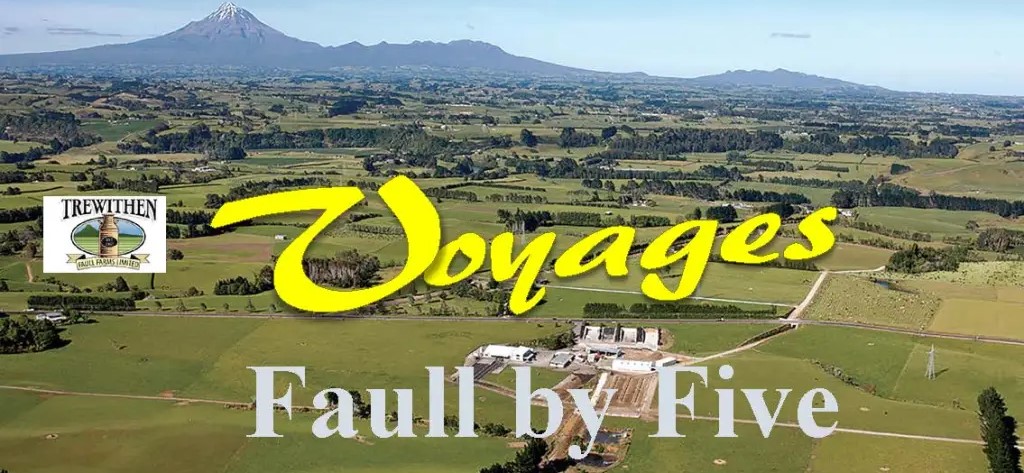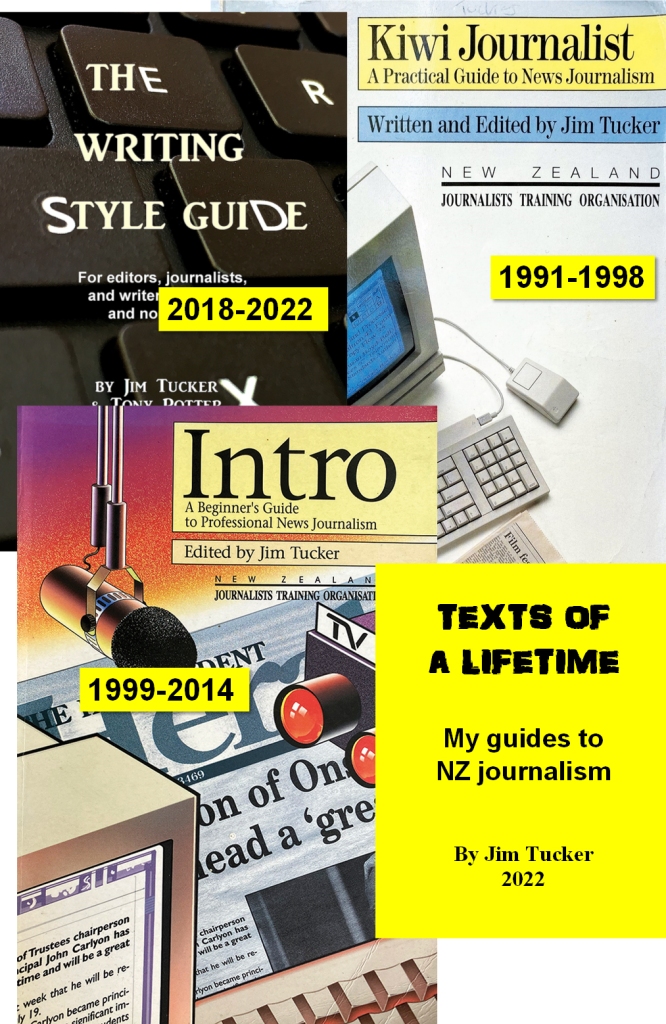
VOYAGES – FAULL by FIVE
By Jim Tucker
THIS NEW account of early Taranaki life and subsequent development was launched at Puke Ariki Library and Museum in New Plymouth in late March, 2024, and can be bought in soft or hard cover at Poppies Bookshop over the road at 7 King St (Ph: 06 769 6990 ).
It’s the outcome of a decade of research, writing, photography and layout/design by Jim and his late brother, photographer Rob Tucker.
The book has about 110,000 words and nearly 500 images, including maps and eight family trees compiled by ancestry researcher, Lin Tucker. She traced one branch of the Faull family back to Vice-Admiral Lord Horatio Nelson in England.
The journey is a largely chronological story that begins with one of the first Māori explorers, Ngāhiri, who settled at Tikorangi in North Taranaki in the 1400s (after Kupe and Te Kakati of Te Ātiawa), and with Cornish miners who came to New Plymouth in 1841 in the first settler ship, William Bryan.
Their families lived alongside each other and inter-married. The tale moves on to the present-day Faull brothers, five descendants who have built interesting and different lives in New Zealand and Australia.
Along the way is the largest chapter, one entitled “The Tragedy of Max”, which tells of the World War II experiences of Max Faull. He died from a sniper’s bullet at the opening of one of the two worst battles experienced by Kiwi service people.
The book was commissioned by middle brother Gavin Faull, who built the family farm into one of the country’s leading dairying operations, as well as managing and owning a chain of 125 hotels world-wide.
All five – the others are Allan, Sir Richard, Archdeacon Bernard and Nigel – have contributed much time and support.
This is not a family history in the usual sense. It’s a detailed account of where a large community of New Zealanders has come from and what they’ve built on the rich, volcanic, dairy-farming plain surrounding Te Maunga Taranaki.
Read the start of the first chapter here (March 2024):
A columnist’s random thoughts

THE ABOVE shows a book I put together a year or two back that looked at what eventuated from some of the hundreds of weekly media (newspaper/online) columns I have written since 2017.
I published the book with the help of funding my retired scientist George Mason and we sold it through the hospices of Taranaki. They took most of the proceeds. Anyone interested in buying a copy should contact Rose Whitaker at the main hospice in New Plymouth: Rose.Whitaker@hospicetaranaki.org.nz
Writing columns for a living doesn’t make sense. There’s little or no money in it and you constantly risk offending everyone, friend or stranger for no better reason than indulging a sense of satisfaction in offending someone who you think is due offence. Mild, of course.
So there it is, a mea culpa from a columnist, now retired because he reckons he’s been lucky to get away with such a frivolous pastime for seven years (still going)..
Too much self-deprecation? Yes. It’s a tempting brake on arrogance and self-satisfaction, is deprecating, but it can be overdone. Which is one of the secrets of column-writing I’m happy to share.
It’s the secret I call my air to hide the fact I can put more than two words together and make some kind of sense that invites you to read on, whether you agree with what I’m saying or not.
It’s nothing to do with insight, this secret, but e dry thing to do with technique. What is does is encourage you to think there’s nothing special going on with this assemblage of words and punctuation and in fact you could undoubtedly do it yourself if you had a mind to.
Many do, these days. And they have the perfect stage for giving it a go – the internet and its blessed social media. Just about anyone can write there because nobody gives a damn about literary skills and clarity.
What people like me are doing is fooling you into thinking it’s easy. It ain’t. Without making too big a deal about it, there’s a lot more to effective non-fiction that a desk, chair, keyboard and kilo of bees’ wax to stick your backside to the job.
There’s a whole lot of polishing goes into a 750-word column. The first draft is often a barely familiar cousin to the last, which may be the 20th.
What comes to mind is the 20th century novelist (name escapes me) who wrote a trilogy of a million or so words – at the rate of a few hundred a day. He revised each day’s work as often as 120 times.
For me, that’s because the first go is about developing the idea, the oft-threadbare inspiration that touched everything off. A brief recognition of something odd, poorly performed or downright unfair in every-day life.
Writing technique with its damnable rules and punctuation barely hang in there as the first manifestation takes shape.
The biggest problem will be length. The second is the beginning, which tends to be an emptying of the mind of flabby thinking that will later need paring to the bone.
There is structure to consider. A Facebook commenter once condemned what became my favourite column – the one about the illegal treehouse (reproduced in this book) because she thought I spent far too long stuffing around before getting to any sort of point. Like on social media. Not.
She was not a reader, I suspect. She hadn’t spent a very long time forced to study the vast variety of writing techniques I’d had to absorb well enough to teach them during the second half of my journalism career.
On that point, I learned most from Janet Frame. Not from her more esoteric novels, which were beyond my ken, but her auto-biographical ones when she told her various life stories.
My meagre analysis picked up at least 30 devices she used to persuade you that this was a good read. Yet few, if any, were obvious.
I worked out that any writing trick obvious to the reader was in fact a failure; a distraction from reading progress, which should be smooth, relentless. For example, a recent column I read had numerous side-thoughts in brackets, a useful tool – but (like this “dash”) no good if the reader starts to notice how many times you use it.
Irritation builds, sometimes to the point where the reader moves to something else. Use such parenthetical instruments, but with restraint.
I’ve used another important one there: avoiding repeated words. The word “devices” changed to “trick” to “tool” to “instruments”. Repeated words in close proximity are, in my view, one of the greatest subconscious distractions you can throw at any reader.
I got quite a way towards perfecting that kind of discreet approach (not for a minute claiming I’m in Frame’s league). If you read one of my better columns you weren’t halted by lack of clarity and shouldn’t have noticed why it flowed without apparent effort. .
There were two constant failures, I suspect. One was showing off my vocabulary, even though in fact I have a typical journalist’s word store of fewer than 2000 words. My excuse was to take advantage of English’s marvellous range and avoid repetition.
The second was sometimes getting too fact-heavy, although the excuse was not wanting to leave the reader with a feeling of frustration at not learning a full story.
Not filling you in is criminal, in my opinion. I noticed that a story about a man who found a fossil bird inside a rock didn’t tell us how he actually got it out without apparent damage to the bones. I wanted to know. I’ll have to look it up. But I’m too busy. Irritation.
The subject topic of columns is vitally important. I deliberately moved between gentle local government probes to wider issues the country was talking about to absolute trivia that hopefully touched a reader chord and made she or he laugh with recognition.
Soap or gel in the shower was an example? Another was the extraordinary longevity of Dan Carter-brand under-daks. And how much of Taranaki would disappear if sea levels rise at the more extreme end of predictions (a lighter look at a deadly serious topic, climate change).
I call much of it “pot-hole journalism” after an early experience I had after moving up to work on the Auckland Star.
New journalism textbook edition

NEW ZEALAND has no current journalism textbook for those learning the occupation here, or even just wanting to see what’s involved.
For that reason, there seems to be some demand for the three textbooks (13 different editions) that I wrote and edited between 1991 and recently. They’re Kiwi Journalist 1995, Intro 2003, and The Writing Style Guide 2018.
Luckily, I still have digital versions of them all, so I’m going back in with an editing hand to lay them out in e-book form to make them available again online. I’ve trialled this already and had good feedback.
You might say everything in journalism has changed since the internet claimed us more than a quarter century ago, but I swear many of the basics haven’t altered much at all: things like interviewing a stranger for a news story, researching for a deep-read feature (things are way better), understanding numbers, meeting deadlines, taking a sharp photo, knowing your cumulo-nimbus from your alto-stratos…and, of course, learning to write in a way that satisfies all the demands of urgency, clarity, flair, accuracy, accessibility, spelling and grammar.
They’re all there in those “old” texts, described in-depth by dozens of the best NZ journalists who ever lived, and, importantly, who worked during the last great era of print journalism. But there’s also lots about radio and TV there, as well, and even tentative attempts to address the fast-moving demands of online media (thanks to the visionary writing of Nigel Horrocks).
Don’t misunderstand – I’m not doing a complete update. How could I – there are more than half a million words there. But that kind of update isn’t needed. The new book – working title Texts of a Lifetime – My guides to NZ journalism – will preserve all the former content, with some adjustments and a much more readable layout. And some new stuff.
There’s too much to combine all three in one new edition, so it will have Kiwi J and Intro in this one and the style guide as a separate e-book that you’ll get for no extra payment if you buy the main combined text.
I’ve completed the update of Kiwi J and quite a few key chapters of Intro, so for a current reduced price of $50 I can send you those two and the style guide now in two manageable pdfs.
Email me at jimtuckermedia@gmail.com and I’ll sort you out a deal.
